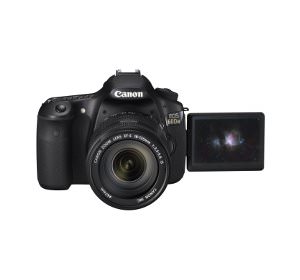Whether you’ve been recently bitten by the astrophotography bug or have been shooting pictures of the cosmos for years, the new Canon 60Da is specifically made with the features you’ll need to shine like a star.

Read real customer reviews of the Canon EOS 60Da here.
1. Although the EOS 60Da looks like the standard 60D model and shares many of the same features, Canon has developed and included a customized infrared blocking filter. The standard filter in a DSLR prevents the reddish hue of hydrogen-alpha (Ha) light gasses (656nm) from falling on the sensor. The 60Da’s filter permits approximately three times as much of Ha light to be recorded, so photography of spectacular nebulae is richer, sharper, more colorful and less diffuse.
2. Canon didn’t hesitate to use the same 18.0-megapixel APS-C size CMOS sensor in the EOS 60Da that is found on the 60D. The sensor has proven to produce exceptional resolution, which is particularly important to astrophotographers. Many of their cosmic images become large prints, which are often cropped to emphasize the color and details of the photos. With the amazing qualities of the 18.0-MP sensor, cropped prints remain clear and crisp and appear to jump from the frame.
3. The sensor in the new Canon EOS 60Da also helps to lessen digital noise. It is often a byproduct of astrophotography, many images of which require higher-than-normal ISO sensitivity and long exposure times. Control of digital noise is further enhanced with the wide spectrum of ISO settings of 100–6,400, which can be increased to 12,800, as a Custom Function.
4. Canon also knew it had a good thing in its DIGIC 4 Image Processor, so it drives the new EOS 60Da DSLR. Just as it serves 60D users so well, the DIGIC 4 provides multiple aspect ratio shooting, in-camera RAW image processing, creative filters and image resizing, plus S2 and S3 image-recording performance. Speed is another of the essential qualities of the DIGIC 4. It records and processes 18.0-MP images at 5.3 fps. That processing is via a 14-bit signal, which ensures that all of the nuances of light, contrast and color are present in the captured image, regardless of what of the exposure formula.
5. Experienced astrophotographers know that the viewing function of a camera is critical. That’s why Canon gave the EOS 60Da a Vari-angle, 3.0-inch Clear View LCD display that swivels into many positions, so it’s easier to frame the cosmos and objects in the sky at various angles, without causing neck strain from long hours of shooting. The monitor is engineered with total flexibility when the EOS 60Da is mounted to a tripod.
The 3.0-inch display is not just convenient; it’s also a superior piece of viewing equipment with next-generation, smudge-resistance; high-transparency materials; and anti-reflective and water-repellant coatings. You’ll be able to identify the details and colors of your subject with great accuracy. With such a precise, sharp view, the LCD becomes an excellent display for reviewing and editing photos. Plus, information for settings, such as ISO, metering modes, AF Point selection and the horizontal Electronic Level, are easily read.
6. Canon proved it understands the needs of astrophotographers when it decided to include its new Remote Controller Adapter RA-E3 on the EOS 60Da. It was specifically designed to work with the optional Timer Remote Controller TC-80N3. Although it’s an additional purchase, this remote switch is an indispensable tool for astrophotographers. With it, the EOS 60Da becomes the best value in an astrophotography-specific camera. The Timer Remote Controller TC-80N3 gives you so many ways to control the time of exposures, with a self-timer, interval timer, long exposure timer and exposure-count setting function. It also provides an enormous range of timer choices, from 1 second to 99 hours. Canon had the smarts to build its remote switch with a dial controller, so the sky-engaged astrophotographer can reach and use it with one hand. Equally convenient are the lighted LCD panel and a 2.6-foot (80cm) cable.
7. The new Canon EOSDa DSLR for astrophotography accepts the entire line of Canon EF and EF-S lenses as well as many Canon accessories, such as the AC Adapter Kit ACK-E6, Angle Finder C and Battery Grip BG-E9.
At the time of this PhotographyTalk article, B&H Photo Video was accepting pre-orders for the new Canon EOSDa DSLR (body only) for $1,499 at http://www.bhphotovideo.com/c/search?Ntt=Canon+EOS+60Da+DSLR&N=0&InitialSearch=yes.
It is predicted to be available during April 2012. It’s important to note that Canon will be releasing this DSLR in limited quantities.
Your feedback is important to thousands of PhotographyTalk.com fans and us. If this article is helpful, then please click the Like and Re-Tweet buttons at the top left of this article.
This blog post about "New Canon EOS 60D DSLR Camera" was first published on our website here https://www.photographytalk.com/photography-equipment-reviews/2268-7-stellar-features-of-the-new-canon-eos-60da-dslr-that-will-help-you-capture-amazing-astrophotography-images